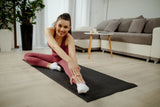
If you spend most of your day sitting—whether at a desk, in a car, or relaxing at home—you may be all too familiar with that nagging lower back pain that creeps in by late afternoon. The culprit? Often, it’s not just your back—it’s your hip flexors.
For women between the ages of 35 and 55 with sedentary lifestyles, tight hip flexors are one of the most overlooked causes of lower back pain. The good news is that a simple daily hip flexor stretch can bring real, lasting relief. And when combined with the right ergonomic support, like a BOD Support seat cushion, you’ll feel the difference almost immediately.
🦴 What Are Hip Flexors, and Why Do They Matter?

Your hip flexors are a group of muscles at the front of your hips that connect your upper thigh to your pelvis and lower spine. These muscles help you lift your knees, bend at the waist, and stabilize your core.
But when you sit for hours each day, these muscles tighten and shorten, pulling on the lower back and tilting your pelvis out of alignment—leading to discomfort, stiffness, and even sharp pain.
🚨 Signs You Have Tight Hip Flexors
-
Lower back pain, especially after sitting
-
Stiffness or discomfort in the front of the hips
-
Poor posture or a forward-tilted pelvis
-
Hip pain while walking or standing
-
Reduced flexibility in your legs or lower back
If any of these sound familiar, your hip flexors might be screaming for a stretch.
✅ The Best Hip Flexor Stretch for Lower Back Pain Relief

You don’t need a gym or yoga class to feel better—just a few feet of space and 5 minutes. Here's a stretch you can do daily to release tension in the hips and ease back pain:
Kneeling Hip Flexor Stretch (Low Lunge Stretch)
Step-by-Step:
-
Kneel on a soft surface (like a yoga mat or cushion) with your right knee on the floor and your left foot forward, creating a 90-degree bend in both knees.
-
Engage your core and gently shift your weight forward, keeping your torso upright.
-
You should feel a stretch along the front of your right hip and thigh.
-
Hold for 30–45 seconds, breathing deeply.
-
Switch sides and repeat.
-
Perform 2–3 rounds on each side daily.
Pro Tip: Avoid arching your lower back. Instead, tilt your pelvis slightly backward (tuck your tailbone) to intensify the stretch and protect your spine.
💺 Combine Stretching with Ergonomic Support for Lasting Relief

While stretching helps release tightness, sitting smarter is just as important. That’s where BOD Support’s memory foam seat cushions come in:
-
Promote proper posture by supporting the spine’s natural curve
-
Reduce hip and tailbone pressure caused by sitting
-
Improve circulation and prevent muscle fatigue
-
Encourage healthy pelvic alignment, reducing strain on hip flexors
By relieving pressure on the hips and spine, your body stays aligned even during long periods of sitting—helping prevent tightness before it starts.
🧘♀️ Make This a Daily Habit

Here’s how to build this simple stretch into your everyday routine:
-
Morning: Start your day with 2–3 rounds per side to loosen up before work.
-
Midday Break: Use it as a posture reset during your lunch break.
-
Evening Wind-Down: Finish your day with the stretch after long hours of sitting.
Bonus: Pair this stretch with gentle pelvic tilts or cat-cow stretches for an even deeper lower back release.

🛍️ Final Thoughts: Stretch, Support, and Sit Better
If you’re dealing with lower back pain from tight hips, relief is closer than you think. A few minutes of hip flexor stretching each day, paired with ergonomic support from BOD Support cushions, can help you feel stronger, more flexible, and pain-free—even if you sit for most of the day.








I RECENTLY HIRED A HIGHLY SKILLED CYBER SPECIALIST
I recently hired a highly skilled cyber specialist to address some hacking issues, and the experience was outstanding. This professional expertly handles tasks like clearing negative online records without any trace, boosting credit scores, and recovering compromised social media accounts. They also offered services such as mobile device cloning which helped me catch my cheating partner, cryptocurrency recovery, and call/location tracking. Their work was genuine, reliable, and professional, with affordable and secure pricing. I highly recommend reaching out to them for any cyber-related problems—they’re a true expert in the field. Contact them at:
Email: Cyberhelpdesk88@gmail.com
Telegram: cyberhelpdesk00